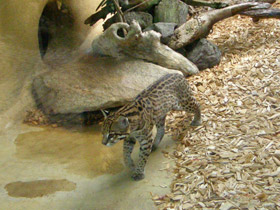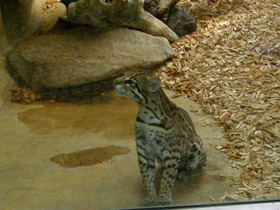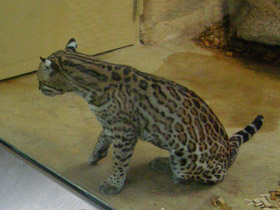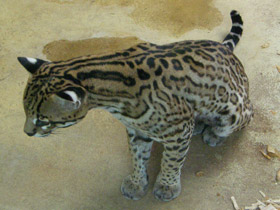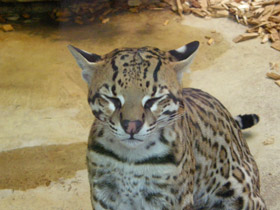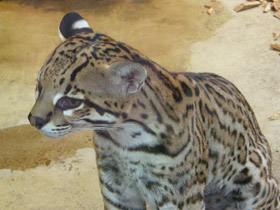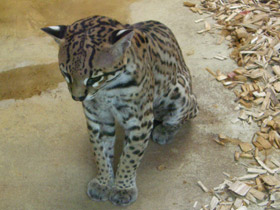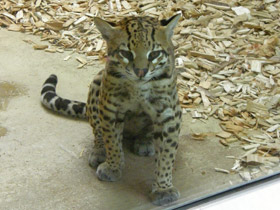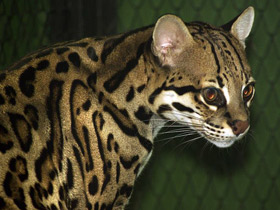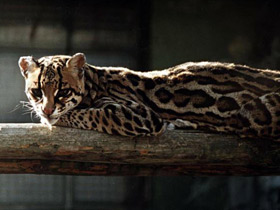The ocelot (Leopardus pardalis)
Habitat
The ocelot (Leopardus pardalis) is a species of carnivorous mammal in the family Felidae.
Leopardus pardalis inhabits the dense forests and scrublands of Mexico, Central America and northeastern South America. It is largely terrestrial and inhabits not only dense tropical forests, but also light scrub and, in Bolivia, climbs high in the mountains. Its northernmost habitat is in the state of Texas.
Appearance
Leopardus pardalis is a medium-sized predator with a graceful body, long, strong legs and a short tail. Its body length is 100 to 140 cm, height 40 to 50 cm, weight 8 to 16 kg and tail length 32 to 41 cm. Its coat is yellowish brown with black ringspots, the coat inside the rings is somewhat darker than around them. The spots are black with longitudinal stripes or rings all over the body, round on the legs and basin-shaped on the back. On the neck and around the shoulders the spots become stripes, on the legs in dots; the belly and chin are painted white; the ears are black with large white dots on the back. It can be confused with the margay or margay (Leopardus wiedii).
Forest-dwelling Leopardus pardalis are more colourful than those living in the plains. Their fur is not as beautiful, but it helps them blend in with their surroundings and make them almost invisible.
Lifestyle and reproduction
Leopardus pardalis lead a solitary lifestyle, except during the breeding season. They are active at night and usually sleep in tree hollows during the day. Leopardus pardalis are territorial, with individual male sites of about 30 km² overlapping with sites of one or more females of half the size. The male periodically scours his domain, entering the female's patches and checking that they are ready to mate.
Gestation lasts between 70 and 80 days and usually produces 2 offspring. The male helps the female to feed her young. Leopardus pardalis makes its den in rocky caves, tree hollows or deep bushes. The young are born blind and covered with soft fur, their eyes open 15-18 days after birth. The mother feeds them on milk for 7 weeks and then gradually switches to adult food. Females reach sexual maturity at 18 months, males at 30 months. After two years, the cubs leave their mother and their domain.
Leopardus pardalis is not only an excellent tree climber, but also a good swimmer. They hunt deer, peccaries, monkeys and large rodents (agouti) at dusk and at night. However, small mammals and birds, as well as reptiles, amphibians and fish, form the basis of their diet. Leopardus pardalis occasionally attacks farm animals and poultry. A female Leopardus pardalis must spend 18 hours a day hunting to feed herself and her young. Leopardus pardalis most often hunts on the ground, but in the southern United States it spends all day high in the trees.
Conservation status
The skin of Leopardus pardalis has long been a popular product. In 1969, for example, more than 133,000 Leopardus pardalis skins were imported into the USA. Due to intensive hunting, Leopardus pardalis has become extremely rare today. Thanks to new intergovernmental agreements, its hunting, as well as the sale of any products made from Leopardus pardalis, is prohibited, as it is listed in Appendix I of CITES.
Etymology
The name "ocelot" comes from the Nahuatl word ōcēlōtl (pronounced [oːˈseːloːt͡ɬ]), which generally refers to the jaguar, rather than the ocelot. Another possible origin for the name is the Latin ocellatus ("having little eyes" or "marked with eye-like spots"), in reference to the cat's spotted coat.
Other vernacular names for the ocelot include cunaguaro (Venezuela), gato onza (Argentina), gato tigre (Panama), heitigrikati (Suriname), jaguatirica, maracaja (Brazil), manigordo (Costa Rica, Panama and Venezuela), mathuntori, ocelote, onsa, pumillo, tiger cat (Belize), tigrecillo (Bolivia) and tigrillo (Colombia, Ecuador, Guatemala, and Peru).
Taxonomy
Felis pardalis was the scientific name proposed for the ocelot by Carl Linnaeus in 1758. The genus Leopardus was proposed by John Edward Gray in 1842 for several spotted cat skins in the collection of the Natural History Museum, London.
Several ocelot specimens were described in the nineteenth and twentieth centuries, including:
- Felis mitis by Frédéric Cuvier in 1824 was a specimen from Rio de Janeiro, Brazil.
- Felis chibi-gouazou by Edward Griffith in 1827 was based on earlier descriptions and illustrations.
- Leopardus griseus by John Edward Gray in 1842 was a spotted cat skin from Central America.
- Felis pseudopardalis by Pierre Boitard in 1845 was an ocelot kept in the Jardin des plantes.
- Felis melanura by Robert Ball in 1844 was a specimen from British Guiana.
- Felis albescens by Jacques Pucheran in 1855 was a specimen from Brownsville, Texas.
- Felis aequatorialis by Edgar Alexander Mearns in 1903 was a skin of an adult female ocelot from Talamanca canton in Costa Rica.
- Felis maripensis and F. sanctaemartae by Joel Asaph Allen in 1904 were skins of two adult female ocelots from Maripa, Venezuela and Santa Marta district in Colombia, respectively.
- Felis pardalis pusaea by Oldfield Thomas in 1914 was an ocelot skin and skull from Guayas Province in coastal Ecuador.
- Felis pardalis nelsoni and Felis pardalis sonoriensis by Edward Alphonso Goldman in 1925 as subspecies of Felis pardalis, based on specimens from Manzanillo and the Mayo River region respectively in Mexico.
- Leopardus pardalis steinbachi by Reginald Innes Pocock in 1941 was a specimen from Buena Vista, Ichilo in Bolivia.
Subspecies
In 1919, Allen reviewed the specimens described until 1914, placed them into the genus Leopardus and recognized nine subspecies as valid taxa based on the colors and spot patterns of skins. In 1941, Pocock reviewed dozens of ocelot skins in the collection of the Natural History Museum and regrouped them to nine different subspecies, also based on their colors and spots. Later authors recognized 10 subspecies as valid.
In 1998, results of a mtDNA control region analysis of ocelot samples indicated that four major ocelot groups exist, one each in Central America, northwestern South America, northeastern South America and southern South America south of the Amazon River. A 2010 study of morphological features noted significant differences in the size and color of the Central and South American populations, suggesting they could be separate species. In 2013, a study of craniometric variation and microsatellite diversity in ocelots throughout the range recognized three subspecies: Leopardus pardalis albescens from the Texas–Mexico border, Leopardus pardalis pardis from Central America and Leopardus pardalis pseudopardalis from South America, though Leopardus pardalis mitis may comprise the ocelot population in the southern part of South America.
In 2017, the Cat Classification Task Force of the IUCN Cat Specialist Group noted that up to four subspecies can be identified, but recognized only two as valid taxa. These two taxa differ in morphological features and are geographically separated by the Andes:
- Leopardus pardalis pardalis has a greyish fur. Its range extends from Texas and Arizona to Costa Rica.
- Leopardus pardalis mitis has a more yellowish fur and is larger than pardalis. It occurs in South America as far south as northern Argentina.
Threats
Throughout its range, the ocelot is threatened by loss and fragmentation of habitat. In Texas, the fertile land that supports dense cover and constitutes the optimum habitat for the ocelot is being lost to agriculture. The habitat is often fragmented into small pockets that cannot support ocelots well, leading to deaths due to starvation. Traffic accidents have emerged as a major threat over the years, as ocelots try to expand beyond their natural habitat to new areas and get hit by vehicles. In the Atlantic Forest in northeastern Argentina, it is affected by logging and poaching of prey species.
The fur trade was a flourishing business in the 1960s and the 1970s that resulted in severe exploitation of felids such as the ocelot and the jaguar. In the 1960s, ocelot skins were among the most highly preferred in the US, reaching an all-time high of 140,000 skins traded in 1970. This was followed by prohibitions on commercial trade of spotted cat skins in several range states such as Brazil and the US, causing ocelot skins in trade to plummet. In 1986, the European Economic Community banned import of ocelot skins, and in 1989, the ocelot was included in Appendix I of the Convention on International Trade in Endangered Species of Wild Fauna and Flora. However, hunting of ocelots for skins has continued and is still a major threat to ocelot survival.
Another threat has been the international pet trade; this typically involves capturing ocelot kittens by killing their mothers; these cats are then sold to tourists. Though it is banned in several countries, pet trade survives; in some areas of Central and South America, ocelots are still sold in a few local markets.

















